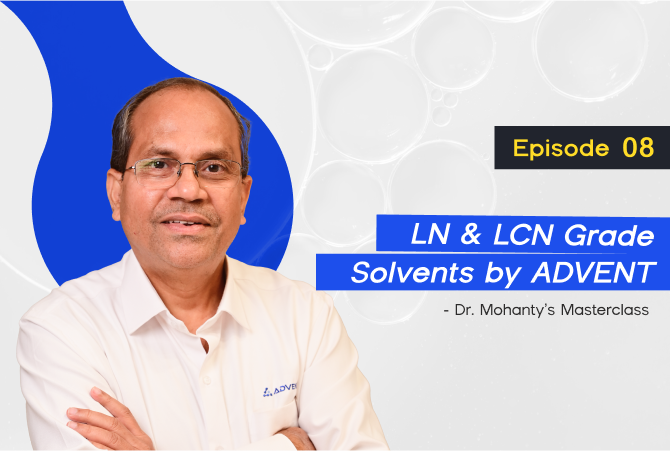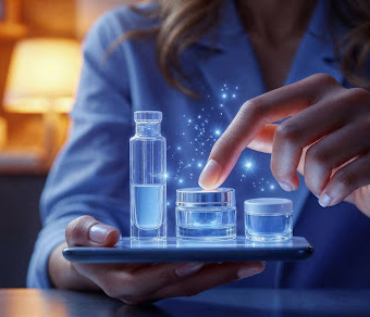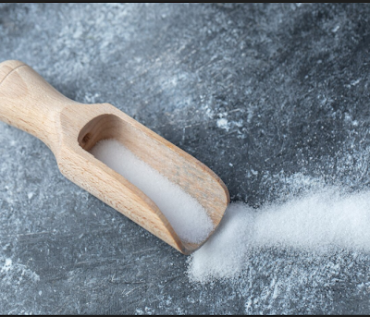It is a story of every researcher, every scientist working in an R&D lab or CRO. There is some undesirable peak that messes with the brain while finding out the source and eliminating it. In the latest episode, Dr. Mohanty shares one such experience from his early career days. Dr. Mohanty and his team had just completed a compound purification and run an NMR analysis. The spectrum looked fine—until it didn’t. A strange peak appeared. A signal that didn’t belong. They checked everything, the reactants, the glassware, and even the technique. Eventually, the culprit was found: the most innocent-looking bottle on the bench—the solvent.
That moment led us to ask a simple yet powerful question at Advent: Can we create solvents that don’t just meet conventional purity standards, but are tested rigorously for the absence of hidden residues that could interfere with high-precision scientific work?
That question became the foundation for the birth of LN and LCN grade solvents—two new solvent grades designed with a single goal: to support your research and disappear without a trace, silently.
The Significance of Solvent Purity in Drug Discovery
In the early stages of drug discovery, when working with milligram-level quantities of compounds, even trace levels of contaminants can obscure real NMR signals, introduce ghost peaks in HPLC, derail synthesis workflows, and cause delays in the projects. Such situations may not be a serious issue in college labs. Still, they may become a grave matter in the Pharmaceutical R&D labs and Contract Research Organizations, sometimes leading to massive setbacks due to trust issues.
These impurities are not merely inconveniences, but a threat to the timelines, reproducibility, and scientific integrity.
What are LN and LCN Solvents?
As Dr. Mohanty explained the significance of Solvent Purity in Drug Discovery, he also introduced LN and LCN solvents to the researchers. At Advent, we designed Low Non-Volatile (LN) and Low Non-Volatile Chromatography (LCN) solvents to serve the modern sciences silently.
LN Solvents: These solvents are specially designed to leave behind virtually no residue after evaporation. This makes it a critical solvent when compound recovery and purity are non-negotiable.
How to test LN Solvents?
To test LN solvents, we make use of a proprietary residual analysis by Proton NMR in which:
A known volume of solvent is completely evaporated.
Next, any residue is again dissolved in the NMR solvent.
This solution is then scanned via 1H NMR.
When no signals in the aliphatic or aromatic regions are obtained, it confirms the absence of organic impurities.
The LN solvents are used to isolate compounds and in the early discovery of the drug candidate process, which requires highly pure chemical compounds.
LCN Solvents: The LCN solvents undergo the same strict residual NMR analysis as the LN solvents, and they go a step further. They also meet the rigorous quality checks expected of the HPLC grade solvents, like UV absorbance/transmittance, residue on evaporation, and the moisture content.
The LCN solvents are used in analytical HPLC, Preparative HPLC, and other analytical techniques where purity and spectral clarity are paramount.
LN vs LCN
Here’s a summary of the differences and similarities between these two solvents:
Despite the slight premium on LCN, both grades embody the same philosophy: no interference, residues, or compromises.
For more information about these solvents, watch Dr. Mohanty’s video on YouTube.
Advent Offers A New Standard in Solvent Purity
Owing to its properties and purity, all the scientists and pharmacists are embracing the LN and LCN solvents in the critical projects in the R&D labs and CROS.
These solvents guarantee they won’t appear in your 1H NMR and HPLC results. Advent has secured trademark registrations for LN and LCN to protect the names and declare our commitment to a new standard of trust in solvent purity.
We offer these solvents in various pack sizes: 2.5 L, 4 L, 25 L, and 50 L SS drums. For more information, visit our website or contact us today.




